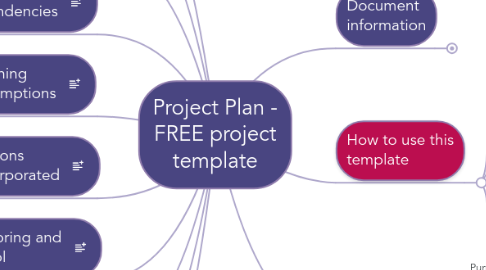
1. Sign-up to edit this map
2. Document information
2.1. Project Name
2.1.1. [name]
2.2. Date
2.2.1. [date]
2.3. Release
2.3.1. Draft/Final
2.4. Author
2.4.1. [author]
2.5. Owner
2.5.1. [owner]
2.6. Client
2.6.1. [client]
2.7. Document Number
2.7.1. [number]
2.8. Revision, Approvals & Distribution
2.8.1. Revision History
2.8.1.1. Revision # [....]
2.8.1.1.1. Revision Date
2.8.1.1.2. Previous Revision Date
2.8.1.1.3. Summary of Changes
2.8.1.1.4. Changes Marked
2.8.1.2. Revision # [....]
2.8.1.2.1. Revision Date
2.8.1.2.2. Previous Revision Date
2.8.1.2.3. Summary of Changes
2.8.1.2.4. Changes Marked
2.8.1.3. Revision # [....]
2.8.1.3.1. Revision Date
2.8.1.3.2. Previous Revision Date
2.8.1.3.3. Summary of Changes
2.8.1.3.4. Changes Marked
2.8.1.4. Date of next revision:
2.8.1.4.1. [....]
2.8.2. Approvals
2.8.2.1. Approval # [....]
2.8.2.1.1. Name
2.8.2.1.2. Signature
2.8.2.1.3. Title
2.8.2.1.4. Date of Issue
2.8.2.1.5. Version
2.8.2.2. Approval # [....]
2.8.2.2.1. Name
2.8.2.2.2. Signature
2.8.2.2.3. Title
2.8.2.2.4. Date of Issue
2.8.2.2.5. Version
2.8.2.3. Approval # [....]
2.8.2.3.1. Name
2.8.2.3.2. Signature
2.8.2.3.3. Title
2.8.2.3.4. Date of Issue
2.8.2.3.5. Version
2.8.3. Distribution
2.8.3.1. Distribution # [....]
2.8.3.1.1. Name
2.8.3.1.2. Title
2.8.3.1.3. Date of issue
2.8.3.1.4. Version
2.8.3.2. Distribution # [....]
2.8.3.2.1. Name
2.8.3.2.2. Title
2.8.3.2.3. Date of issue
2.8.3.2.4. Version
3. Overview
3.1. Purpose
3.1.1. A plan provides a statement of how and when objectives are to be achieved, by showing the major products, activities and resources required for the scope of the plan. In PRINCE2, there are three levels of plan: project, stage and team. Team Plans are optional and may not need to follow the same composition as a Project Plan or Stage Plan.
3.1.2. An Exception Plan is created at the same level as the plan that it is replacing.
3.1.3. A Project Plan provides the Business Case with planned costs, and it identifies the management stages and other major control points. It is used by the Project Board as a baseline against which to monitor project progress.
3.1.4. Stage Plans cover the products, resources, activities and controls specific to the stage and are used as a baseline against which to monitor stage progress.
3.1.5. Team Plans (if used) could comprise just a schedule appended to the Work Package(s) assigned to the Team Manager.
3.1.6. A plan should cover not just the activities to create products but also the activities to manage product creation - including activities for assurance, quality management, risk management, configuration management, communication and any other project controls required.
3.2. Contents
3.2.1. The Plan should cover the following topics.
3.2.2. Plan Description
3.2.3. Plan Prerequisites
3.2.4. External Dependencies
3.2.5. Planning Assumptions
3.2.6. Lessons Incorporated
3.2.7. Monitoring and Control
3.2.8. Budgets
3.2.9. Tolerances
3.2.10. Product Descriptions
3.2.11. Schedule
3.3. Advice
3.3.1. The Plan is derived from the Project Brief, Quality Management Strategy (for quality management activities to be included in the plan), Risk Management Strategy (for risk management activities to be included in the plan), Communication Management Strategy (for communication management activities to be included in the plan), Configuration Management Strategy (for configuration management activities to be included in the plan), Resource availability, and Registers and logs.
3.3.2. The Plan can take a number of formats including: A stand-alone document or a section of the Project Initiation Documentation; Document, spreadsheet, presentation slides or mindmap; Entry in a project management tool.
3.3.3. The schedule may be in the form of a product checklist (which is a list of the products to be delivered within the scope of the plan, together with key status dates such as draft ready, quality inspected, approved etc.) or the output from a project planning tool.
3.3.4. The following quality criteria should be observed:
3.3.4.1. The plan is achievable
3.3.4.2. Estimates are based on consultation with the resources, who will undertake the work, and/or historical data
3.3.4.3. Team Managers agree that their part of the plan is achievable
3.3.4.4. It is planned to an appropriate level of detail (not too much, not too little)
3.3.4.5. The plan conforms to required corporate or programme standards
3.3.4.6. The plan incorporates lessons from previous projects
3.3.4.7. The plan incorporates any legal requirements
3.3.4.8. The Plan covers management and control activities (such as quality) as well as the activities to create the products in scope
3.3.4.9. The plan supports the Quality Management Strategy, Configuration Management Strategy, Risk Management Strategy, Communication Management Strategy and project approach
3.3.4.10. The plan supports the management controls defined in the Project Initiation Documentation
4. How to use this template
4.1. How to share this template with your team
4.1.1. Send an email
4.1.1.1. 1. Click Share this map
4.1.1.2. 2. Select Invite People
4.1.1.3. 3. Write a message
4.1.1.4. 4. Click Invite
4.1.2. Send a link
4.1.2.1. 1. Click Share this map
4.1.2.2. 2. Tick Link to share
4.1.2.3. 3. Copy the link to share it
4.1.3. Export
4.1.3.1. 1. Click down arrow, bottom right
4.1.3.2. 2. Select the export option you want
4.2. How to complete this template
4.2.1. Complete the sections in square brackets
4.2.1.1. [....]
4.2.2. Read these sections for help on this template
4.2.2.1. Purpose
4.2.2.2. Advice
4.2.3. Navigate using the links in Contents
4.2.3.1. Contents
4.3. Attribution
4.3.1. Copyright © AXELOS Limited 2009. All rights reserved. Material is reproduced with the permission of AXELOS
4.4. Get this template here
5. Schedule
5.1. This may include or reference graphical representations of the following:
5.1.1. Gantt or bar chart
5.1.2. Product breakdown structure
5.1.3. Product flow diagram
5.1.4. Activity Network
5.1.5. Table of resource requirements – by resource type (e.g. four engineers, one test manager, one business analyst)
5.1.6. Table of requested/assigned specific resources –by name (e.g. Nikki, Jay, Francesca)
5.1.7. The Schedule may also be in the form of a Product Checklist as shown below
5.1.8. Product Checklist
5.1.8.1. Product Identifier
5.1.8.1.1. [...]
5.1.8.2. Product Title
5.1.8.2.1. [...]
5.1.8.3. Product Description approved
5.1.8.3.1. Plan
5.1.8.3.2. Actual
5.1.8.4. Draft Ready
5.1.8.4.1. Plan
5.1.8.4.2. Actual
5.1.8.5. Final Quality Check completed
5.1.8.5.1. Plan
5.1.8.5.2. Actual
5.1.8.6. Approved
5.1.8.6.1. Plan
5.1.8.6.2. Actual
5.1.8.7. Handed Over (if applicable)
5.1.8.7.1. Plan
5.1.8.7.2. Actual
